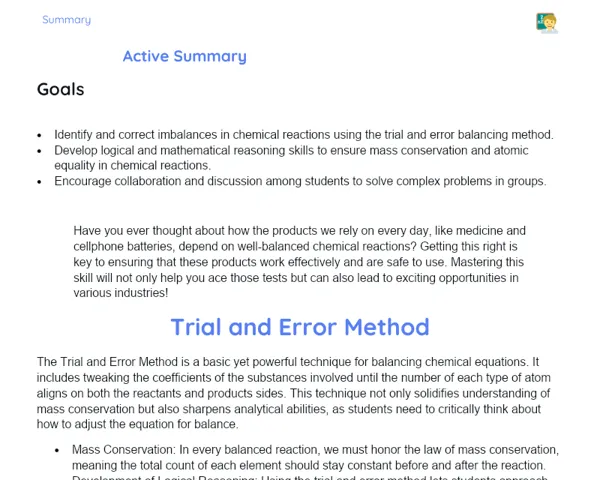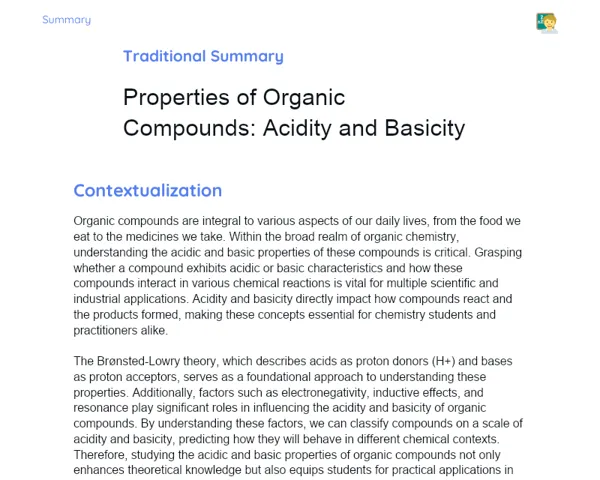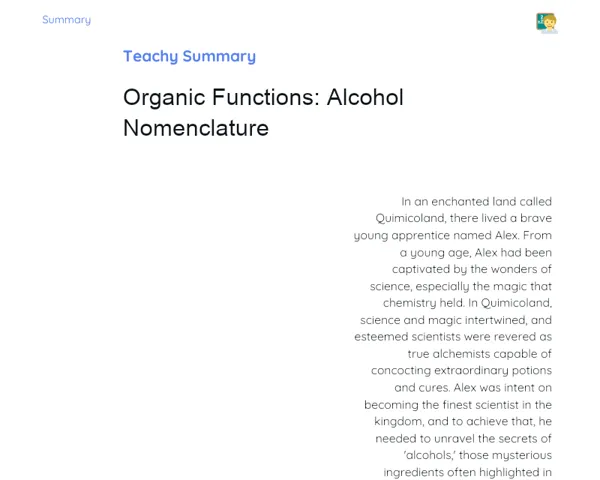Socioemotional Summary Conclusion
Goals
1. 💡 Understand the concept of dilution and how it relates to solution concentrations.
2. 🧪 Learn to calculate the concentration of a solution after adding a solvent using chemical formulas.
3. 🤔 Identify and manage the emotions associated with tackling math and science challenges, fostering self-awareness and self-regulation.
Contextualization
Did you know that making lemonade involves some chemistry? When you add water to lemon juice, you’re diluting the solution, which means you’re reducing its concentration. This important principle is also applied in medicine for adjusting medication dosages and in labs for preparing specific solutions. Let’s explore how to calculate these dilutions and see how they’re relevant in our everyday lives! 🇿🇦🔬
Exercising Your Knowledge
Definition of Dilution
Dilution is the process of lowering the concentration of a solute in a solution by adding more solvent. While the amount of solute stays the same, the overall volume of the solution increases. This concept is crucial not only in chemistry but also in daily activities, like making drinks or adjusting medication dosages.
-
✅ Constant Amount of Solute: The amount of solute remains unchanged; only more solvent is added.
-
✅ Total Volume Increases: Adding more solvent increases the overall volume of the solution.
-
✅ Everyday Dilution: For example, by adding water to concentrated juice, you dilute it.
Dilution Formula
The dilution formula, C1 x V1 = C2 x V2, brings together the concentrations and volumes of solutions before and after dilution. Here, C denotes concentration, and V signifies volume. This formula is vital for solving dilution problems, whether in school or real-life scenarios.
-
📊 Initial and Final Concentration: C1 and C2 represent the concentrations before and after dilution.
-
📏 Initial and Final Volume: V1 and V2 denote the volumes before and after dilution.
-
✏️ Practical Application: This helps to find out how much solvent to add for a desired concentration.
Practical Example
Imagine you have 1 liter of an HCl solution with a concentration of 2 mol/L and want to dilute it to 1 mol/L. Using the dilution formula, you'd see that you need to increase the solution’s volume to 2 liters. This practical approach demystifies the process and shows how to apply the concept in real life.
-
🔍 Applying the Formula: Use the formula to figure out how much solvent to add.
-
🧪 Practical Relevance: This example is relevant in labs and when preparing medication.
-
📋 Step-by-Step: Follow a structured approach to tackle dilution problems.
Key Terms
-
Dilution: The process of reducing a solute's concentration in a solution.
-
Concentration: The quantity of solute in a given volume of solvent.
-
Solute: The substance dissolved in the solution.
-
Solvent: The substance that dissolves the solute.
-
C1 x V1 = C2 x V2: A formula for calculating dilutions.
For Reflection
-
🧠 What emotions did you experience while solving dilution calculations? How did you manage these emotions?
-
🧠 In what ways can self-control assist you when handling complex problems like dilution calculations?
-
🧠 How can an understanding of the dilution process be beneficial in daily life and other areas of study?
Important Conclusions
-
🌟 We grasped the concept of dilution and its relevance in both chemistry and everyday situations.
-
🧭 We learned how to calculate the concentration of a solution after adding a solvent using the formula C1 x V1 = C2 x V2.
-
🤔 We reflected on our emotions during problem-solving, enhancing self-awareness and self-control skills.
Impacts on Society
Understanding the dilution process significantly impacts various sectors of society. For instance, in healthcare, many medications require dilution for proper dosages, ensuring patient safety and efficacy. This knowledge is also crucial in laboratories, as precise solution preparation can directly affect scientific outcomes. 🎯✨ On a personal level, mastering dilution can enhance students' confidence when facing scientific and mathematical challenges, leading to a sense of accomplishment. Moreover, applying these concepts in daily tasks, like cooking or beverage preparation, fosters critical thinking and informed decision-making in various life aspects. 💪👩🔬
Dealing with Emotions
To navigate through emotions while studying dilution and its applications, here's a simple exercise: Start by acknowledging how you feel when faced with a dilution problem. Ask yourself, 'Am I anxious? Frustrated? Excited?'. Then, delve into the reason behind these feelings. Is it due to the difficulty of the problem? Or the satisfaction that comes with solving it? Clearly identify these emotions. Share these feelings respectfully by talking to peers or jotting them down in a journal. Lastly, practice emotional regulation techniques. If tension arises, consider deep breathing exercises to calm and refocus. 🧘♂️💭
Study Tips
-
📘 Practice regularly with exercises: Working through various dilution problems can enhance your understanding and build confidence.
-
🌐 Utilise online resources: Explore videos and interactive simulators to help visualize the dilution process and the application of formulas.
-
👥 Study in groups: Engaging with peers to share ideas and discuss problem-solving strategies can enrich your learning experience and make it enjoyable.



